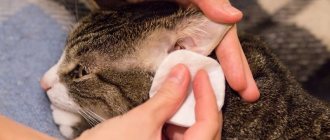Aggression poses a danger not only to the victim, but also to the source itself. Cats have a good sense of self-preservation, so the manifestation of inappropriate behavior indicates that they simply have no other choice but to attack. Before attacking, animals strongly signal to the source of irritation with their paws and body movements that they are furious. With the help of its body, an aggressive cat warns and in every possible way drives away the enemy.
It is worth remembering that cats are not aggressors for the sake of aggression itself. There are a number of obvious reasons that are responsible for this behavior in an animal. The owner’s task is to contact a veterinarian or animal psychologist for advice, which will allow the cause to be determined as accurately as possible and help the pet by eradicating aggression.
Play aggression
A kitten or young cat can behave very rudely during play: scratching, biting, hunting for a person and attacking from an ambush.
Do not encourage your pet's aggressive behavior / bandofcats.com
The reason is that the animal simply does not know how to control itself. Cats typically learn to communicate when they grow up with their peers. This is how they learn that aggression can be met with a mirror response or the fun will end. But those kittens that were taken from their mother before the age of three months did not have time to acquire social skills. Therefore, they can play very harshly and simply do not understand that such behavior is unacceptable.
According to researchers of Common feline problem behaviors: Owner-directed aggression, the only pets that never go for walks and those whose owners prefer rather rough games can also show aggression. Such predatory habits are also typical for some breeds in general, for example, Bengal cats.
What to do about it
First, determine if there is a pattern when aggression occurs. For example, an animal hides under a bed when preparing to jump. To prevent an attack, distract your furry with a game or simply block access to ambush areas. An ordinary bell on the collar can tell you where the pet is.
Also try to switch your cat's attention to different toys. But do not expose your hands to scratching and biting: the animal may perceive this as a general game, which will provoke new aggression.
Don't punish your cat: sometimes this causes fear of people. If you see an animal showing play aggression, simply ignore it and walk away. This way the pet will understand that his actions do not lead to a common game.
Pamper your pet ⚽
- 35 cool products for cats and their owners
Causes
Aggression in cats can have a variety of manifestations. There are a large number of reasons why cats develop outright hostility towards someone or something. The owner of the animal must clearly determine what caused this behavior in the pet.
An important and basic step that a cat owner must take is to bring it to a veterinarian. It is not advisable to skip examination and diagnostic procedures by a qualified doctor, since the pet can be aggressive due to severe pain and poor general condition.
Without knowing the exact reason for the inappropriate behavior, the owner will continue to ignore the animal or intensively educate it, which will not lead to positive results.
Aggression in any form (play, during an attack) is a dangerous condition that can harm both the cat owner and other surrounding animals and people. It is necessary to take measures to eliminate the pet’s specific behavior only after consultation with a veterinarian and zoopsychologist.
The basic types of aggressive cat behavior are:
- Aggression within one species . Characteristic of several animals at war with each other (two males in the house). Intraspecific aggression is also typical for unfamiliar cats encountered on neutral territory. The appearance of malicious behavior is also observed in cats that were previously friends and peacefully coexisted in the same territory.
- Redirected aggression in cats . It occurs against the background of the fact that the animal saw or heard something that irritates it. For example, a cat, sitting peacefully at home, saw a potential enemy in the window and, outraged by the inability to reach him, begins to show aggression at home, taking out her anger on the owner. The most aggressive cat breeds are Oriental. They are excitable and ready to rush at a potential enemy at the same hour.
- Aggression due to fear . The basis of all types of aggression is animal fear. A pet that has been driven into a corner can be aggressive. The animal does not feel protected, tries to protect itself and begins to attack first. The vast majority of owners assume that the cat has suddenly become aggressive. In fact, the mustachioed pet gives a lot of signs warning of possible danger and attack. The main problem is that cat owners, especially small children, do not notice the signs and become the target of aggression. Most often, aggression caused by fear is observed by veterinary specialists when the animal is brought to them for an appointment. Veterinarians are the ones who often see cats in a state of fear-induced aggression.
- Aggression associated with games. Often, owners of domestic cats are “attacked” by their pets on their feet, ankles or slippers. For a cat, this is a kind of game, and not always caused by anger. Most often this is just a manifestation of hunting instincts. However, if this pet behavior is not stopped in time, it may become more aggressive in the future.
- Aggression of a territorial nature. This is one of the main causes of aggression between cats within a pack. Territorial aggression manifests itself quite often and is characterized by hissing, taking threatening poses, as well as a kind of territorial war. Cats begin to arch their backs at their relatives, hiss and indicate in every possible way that they no longer recognize him.
- Aggression caused by pain. Such aggression occurs when the owner, without knowing it, begins to touch or stroke the place where the animal hurts. Aggression in a cat is a response to when a small child climbs too intrusively towards her, pulls her tail, or steps on her paws. In older cats, pain-induced aggression occurs when arthritis develops.
- Unprovoked aggression . This is sudden aggression in a cat that occurs without an immediate cause. In this rare case, the cause is most likely a mental disorder. Before diagnosing unprovoked aggression, it is important to rule out medical causes and all other possible causes of aggression.
- Mother cat defensive aggression . The manifestation of anger and aggression in a cat that has recently given birth to kittens is quite understandable behavior. It is normal to keep strangers, including the owner, away from your offspring. It is not recommended to touch the babies unnecessarily and disturb the mother cat herself.
Aggression as a manifestation of fear
In certain situations, your pet feels cornered and defends itself if there is no way to escape. This often happens when a cat encounters an unfamiliar animal, person, or even noise. Although sometimes the owners can be frightening.
Another possible situation is events associated with less than pleasant experiences, such as a visit to the veterinarian.
During aggression, which is caused by fear, the cat tries to protect itself / webmd.com
This problem also occurs in animals that are not accustomed to people since childhood or are regularly subjected to physical punishment.
What to do about it
In such a situation, it is better to leave the pet alone for a while and give it the opportunity to come to its senses. It is important not to show fear. This behavior will only intensify if the cat realizes that you have retreated.
You should not reassure your pet; this may be perceived as encouragement. Lack of attention is the best way to deal with aggression caused by fear.
Take note











